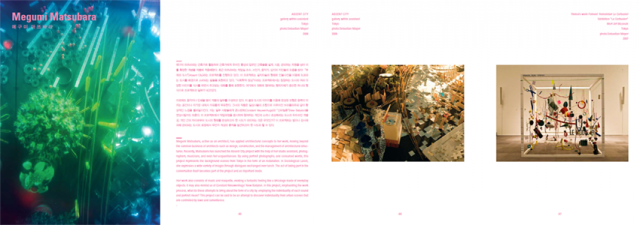Point, Group Exhibition curated by Fumihiko Sumitomo, Seung Wan Kang, Mijin Kim, Jinsuk Suh, Jinsang Yoo
Alternative Space LOOP, Seoul
August 29–September 24, 2008
FUMIHIKO SUMITOMO
These days, it is easy to feel the amount of information we are able to access rapidly increasing due to enhanced telecommunication via the Internet and transportation via airplane. The rapidly changing media makes the general public, who are for the most part not wealthy or powerful men, into the all-encompassing possessor of memories, which can be perceived as dreadful in many ways. However, without using the ben- efits of such technical development, an exhibition like this could not be achieved.
As we enjoy the benefits of human-centered technology and industry, looking at long-term issues such as the destruction of the environment and the depletion of oil resources confirms the existence of this phenom- enon. Such social change, however, is not always degenerative. As the exchange of information increases, unequal opportunity has been removed and benefits formerly monopolized by a privileged few are now able to be shared by the general public. A positive attitude towards change is in line with efforts to overcome the above-mentioned long-term problems.
It is sometimes easier for us to criticize something than to affirm it. When facing things we have never experi- enced before, we often rely on our personal senses to refresh our layers of thoughts and senses, rather than making judgments of right and wrong on the basis of transcendental, essential propositions. In the realm of representation, however, society is formed by offering wholeness to both the internal and external sides of an individual. Therefore, we see the world from the viewpoints of men, Japanese, gays, and curators alike. Thus, a sense of the incongruity of each individual is oppressed. If viewing the world from this stance, we can see that its limitations are absolute.
Politics can also be practiced using the force of representation, which is also involved in marketing and brand- ing in economic terms. Meanwhile, culture uses the concept of representation to explore and reveal its own identity. Since the 1990s when multi-culturalism started being advocated in the art world, the political, indus- trial tendency of culture has remained pervasive. Cultural exchanges between different nations have been generally seen in a positive light and much money is spent on such activities. However, we should not be too excessively bound to the framework of cultural exchange. We should make sure to critically consider which points we should focus on in cultural exchange as well as the specific factors suppressing it.
Hikaru Fujii presents works of art using scenes from TV that are quite familiar to us. The simple, intense commercial images of sports brands have played a vital part in their success in the world market. His work exposes the actions and techniques of a sports player who has the highest level of physical capability and presents them like scenes from real games. In this work, martial artists seem to be entangled with one another, lending a tense atmosphere to the canvas. They press down each other making rustling sounds. Upon closer examination, however, one figure appears like a riot police officer holding a shield while the other is just a defenseless, ordinary person. As found in many rallies and demonstrations, the work captures citizens talking with each other and being oppressed by higher power. Their dynamic bodies are shown confronting each other and evoke a feeling quite different from the dynamism of above-mentioned commercial images. Unlike the intention of industrial media to infiltrate such exquisite images into video scenes, this work has more of a political underpinning bringing up issues such as sports brands’ exploitation of labor in the third world and the conspiracy between sports and state power.
Satoshi Hashimoto has produced new work for this exhibition. He has so far worked in performance, video, and installation, urging viewers to actively engage in his work. Thus, the work seems to permeate into the viewer’s daily life rather than being something only directly associated with his pieces. His work simply stares at occurring phenomena, instead of questioning the meanings of images and actions. In this sense, his work is both a one-time experience as well as non-representational. Bilaterally conflicting elements simultaneously appear in his work, thereby locating viewers somewhere in between tension and relaxation, activeness and passiveness. His work explores the meaning of what he hopes to perceive.
Megumi Matsubara, active as an architect, has applied architectural concepts to her work, moving beyond the common business of architects such as design, construction, and the management of architectural structures. Recently, Matsubara has launched the Absent City project with the help of her studio assistant, photographers, musicians, and even her acquaintances. By using portrait photographs, and consumed words, this project represents the background scenes from Tokyo in the form of an installation. In Sociological Lunch, she expresses a wide variety of images through dialogues exchanged over lunch. The act of taking part in the conversation itself becomes part of the project and an important mode.
Her work also consists of music and maquette, evoking a fantastic feeling like a bricolage made of everyday objects. It may also remind us of Constant Nieuwenhugs’ New Babylon. In this project, emphasizing the work process, what do these attempts to bring about the form of a city by employing the individuality of each sound and portrait mean? This project can be said to be an attempt to discover individuality from urban scenes that are controlled by laws and surveillance.
The above three artists work with different materials in the different fields of video, physicality, and architec- ture. Art can be a measure to overcome disruption and contradiction among individuals. That is in no way the revelation of an individual’s torturous experience but a means to flexibly, freely face an individual’s realities entangled with his social stance and role.
Appearance: POINT (Exhibition Catalogue), August 2008

